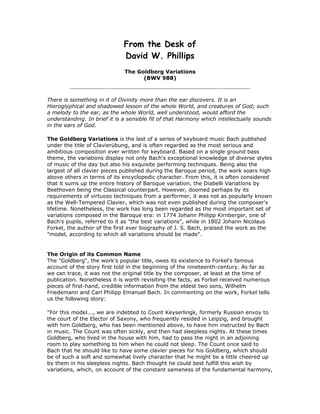
Goldberg Variations
- 1. From the Desk of David W. Phillips The Goldberg Variations (BWV 988) There is something in it of Divinity more than the ear discovers. It is an Hieroglyphical and shadowed lesson of the whole World, and creatures of God; such a melody to the ear, as the whole World, well understood, would afford the understanding. In brief it is a sensible fit of that Harmony which intellectually sounds in the ears of God. The Goldberg Variations is the last of a series of keyboard music Bach published under the title of Clavierübung, and is often regarded as the most serious and ambitious composition ever written for keyboard. Based on a single ground bass theme, the variations display not only Bach's exceptional knowledge of diverse styles of music of the day but also his exquisite performing techniques. Being also the largest of all clavier pieces published during the Baroque period, the work soars high above others in terms of its encyclopedic character. From this, it is often considered that it sums up the entire history of Baroque variation, the Diabelli Variations by Beethoven being the Classical counterpart. However, doomed perhaps by its requirements of virtuoso techniques from a performer, it was not as popularly known as the Well-Tempered Clavier, which was not even published during the composer's lifetime. Nonetheless, the work has long been regarded as the most important set of variations composed in the Baroque era: in 1774 Johann Philipp Kirnberger, one of Bach's pupils, referred to it as "the best variations", while in 1802 Johann Nicolaus Forkel, the author of the first ever biography of J. S. Bach, praised the work as the "model, according to which all variations should be made". The Origin of its Common Name The "Goldberg", the work's popular title, owes its existence to Forkel's famous account of the story first told in the beginning of the nineteenth-century. As far as we can trace, it was not the original title by the composer, at least at the time of publication. Nonetheless it is worth revisiting the facts, as Forkel received numerous pieces of first-hand, credible information from the eldest two sons, Wilhelm Friedemann and Carl Philipp Emanuel Bach. In commenting on the work, Forkel tells us the following story: "For this model..., we are indebted to Count Keyserlingk, formerly Russian envoy to the court of the Elector of Saxony, who frequently resided in Leipzig, and brought with him Goldberg, who has been mentioned above, to have him instructed by Bach in music. The Count was often sickly, and then had sleepless nights. At these times Goldberg, who lived in the house with him, had to pass the night in an adjoining room to play something to him when he could not sleep. The Count once said to Bach that he should like to have some clavier pieces for his Goldberg, which should be of such a soft and somewhat lively character that he might be a little cheered up by them in his sleepless nights. Bach thought he could best fulfill this wish by variations, which, on account of the constant sameness of the fundamental harmony,
- 2. he had hitherto considered as an ungrateful task. But as at this time all his works were models of art, these variations also became such under his hand. This is, indeed, the only model of the kind that he has left us. The Count thereafter called them nothing but his variations. He was never weary of hearing them; and for a long time, when the sleepless nights came, he used to say: "Dear Goldberg, do play me one of my variations." Bach was, perhaps, never so well rewarded for any work as for this: the Count made him a present of a golden goblet, filled with a hundred Louis d'ors. But their worth as a work of art would not have been paid if the present had been a thousand times as great." Aria Variatio 1 Variatio 2 Variatio 3 Canonne All' Unisono Variatio 4 Variatio 5 Variatio 6 Cannone Alla Seconda Variatio 7 Variatio 8 Variatio 9 Cannone Alla Terza Variatio10 Fughetta Variatio 11 Variatio 12 Cannone Alla Quarta Variatio 13 Variatio 14 Variatio 15 Canone Alla Quinta INTERMISSION Variatio 16 Ouverture Variatio 17 Variatio 18 Canone ASlla Sesta Variatio 19 Variatio 20 Variatio 21 Canone Alla settima Variatio 22 Alla brve Variatio 23 Variatio 24 Canonne All' Ottava Variatio 25 Variatio 26 Variatio 27 Cannone Alla Nona Variatio 28 Variatio 29 Variatio 30 Quodlibet Aria da Capo 1453 Prospect Place, Apt 1 G, Brooklyn, NY 11213 Tele: 347 414 5321 Web: www.DavidPhillipsPianist.com E mail: Daviddwp2@earthlink.net